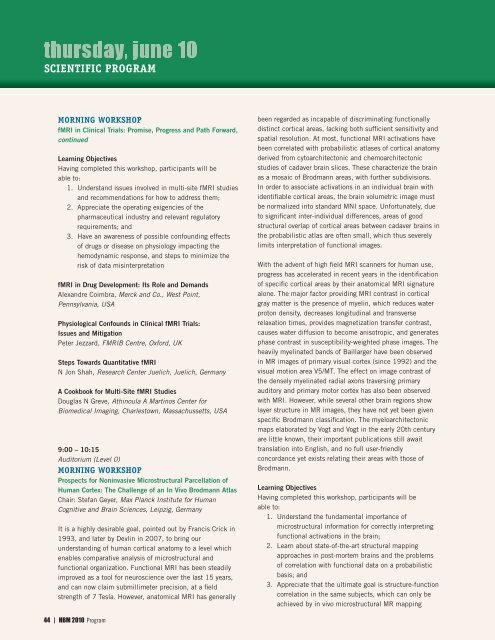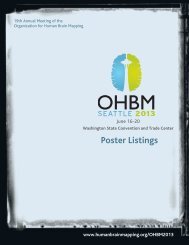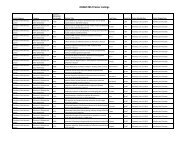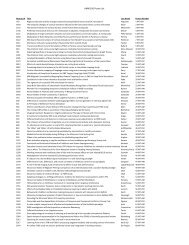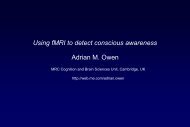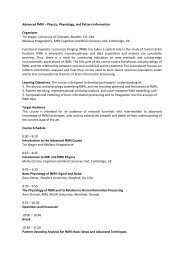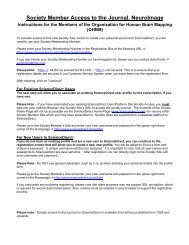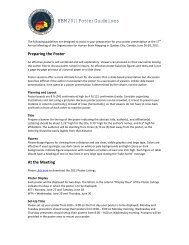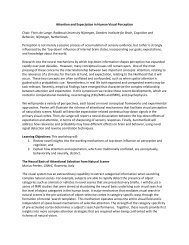HBM2010 - Organization for Human Brain Mapping
HBM2010 - Organization for Human Brain Mapping
HBM2010 - Organization for Human Brain Mapping
You also want an ePaper? Increase the reach of your titles
YUMPU automatically turns print PDFs into web optimized ePapers that Google loves.
SCIENTIFIC PROGRAM<br />
MORNING WORKSHOP<br />
fMRI in Clinical Trials: Promise, Progress and Path Forward,<br />
continued<br />
Learning Objectives<br />
Having completed this workshop, participants will be<br />
able to:<br />
1. Understand issues involved in multi-site fMRI studies<br />
and recommendations <strong>for</strong> how to address them;<br />
2. Appreciate the operating exigencies of the<br />
pharmaceutical industry and relevant regulatory<br />
requirements; and<br />
3. Have an awareness of possible confounding effects<br />
of drugs or disease on physiology impacting the<br />
hemodynamic response, and steps to minimize the<br />
risk of data misinterpretation<br />
fMRI in Drug Development: Its Role and Demands<br />
Alexandre Coimbra, Merck and Co., West Point,<br />
Pennsylvania, USA<br />
Physiological Confounds in Clinical fMRI Trials:<br />
Issues and Mitigation<br />
Peter Jezzard, FMRIB Centre, Ox<strong>for</strong>d, UK<br />
Steps Towards Quantitative fMRI<br />
N Jon Shah, Research Center Juelich, Juelich, Germany<br />
A Cookbook <strong>for</strong> Multi-Site fMRI Studies<br />
Douglas N Greve, Athinoula A Martinos Center <strong>for</strong><br />
Biomedical Imaging, Charlestown, Massachussetts, USA<br />
9:00 – 10:15<br />
Auditorium (Level 0)<br />
MORNING WORKSHOP<br />
Prospects <strong>for</strong> Noninvasive Microstructural Parcellation of<br />
<strong>Human</strong> Cortex: The Challenge of an In Vivo Brodmann Atlas<br />
Chair: Stefan Geyer, Max Planck Institute <strong>for</strong> <strong>Human</strong><br />
Cognitive and <strong>Brain</strong> Sciences, Leipzig, Germany<br />
It is a highly desirable goal, pointed out by Francis Crick in<br />
1993, and later by Devlin in 2007, to bring our<br />
understanding of human cortical anatomy to a level which<br />
enables comparative analysis of microstructural and<br />
functional organization. Functional MRI has been steadily<br />
improved as a tool <strong>for</strong> neuroscience over the last 15 years,<br />
and can now claim submillimeter precision, at a field<br />
strength of 7 Tesla. However, anatomical MRI has generally<br />
been regarded as incapable of discriminating functionally<br />
distinct cortical areas, lacking both sufficient sensitivity and<br />
spatial resolution. At most, functional MRI activations have<br />
been correlated with probabilistic atlases of cortical anatomy<br />
derived from cytoarchitectonic and chemoarchitectonic<br />
studies of cadaver brain slices. These characterize the brain<br />
as a mosaic of Brodmann areas, with further subdivisions.<br />
In order to associate activations in an individual brain with<br />
identifiable cortical areas, the brain volumetric image must<br />
be normalized into standard MNI space. Un<strong>for</strong>tunately, due<br />
to significant inter-individual differences, areas of good<br />
structural overlap of cortical areas between cadaver brains in<br />
the probabilistic atlas are often small, which thus severely<br />
limits interpretation of functional images.<br />
With the advent of high field MRI scanners <strong>for</strong> human use,<br />
progress has accelerated in recent years in the identification<br />
of specific cortical areas by their anatomical MRI signature<br />
alone. The major factor providing MRI contrast in cortical<br />
gray matter is the presence of myelin, which reduces water<br />
proton density, decreases longitudinal and transverse<br />
relaxation times, provides magnetization transfer contrast,<br />
causes water diffusion to become anisotropic, and generates<br />
phase contrast in susceptibility-weighted phase images. The<br />
heavily myelinated bands of Baillarger have been observed<br />
in MR images of primary visual cortex (since 1992) and the<br />
visual motion area V5/MT. The effect on image contrast of<br />
the densely myelinated radial axons traversing primary<br />
auditory and primary motor cortex has also been observed<br />
with MRI. However, while several other brain regions show<br />
layer structure in MR images, they have not yet been given<br />
specific Brodmann classification. The myeloarchitectonic<br />
maps elaborated by Vogt and Vogt in the early 20th century<br />
are little known, their important publications still await<br />
translation into English, and no full user-friendly<br />
concordance yet exists relating their areas with those of<br />
Brodmann.<br />
Learning Objectives<br />
Having completed this workshop, participants will be<br />
able to:<br />
1. Understand the fundamental importance of<br />
microstructural in<strong>for</strong>mation <strong>for</strong> correctly interpreting<br />
functional activations in the brain;<br />
2. Learn about state-of-the-art structural mapping<br />
approaches in post-mortem brains and the problems<br />
of correlation with functional data on a probabilistic<br />
basis; and<br />
3. Appreciate that the ultimate goal is structure-function<br />
correlation in the same subjects, which can only be<br />
achieved by in vivo microstructural MR mapping<br />
44 | HBM 2010 Program


